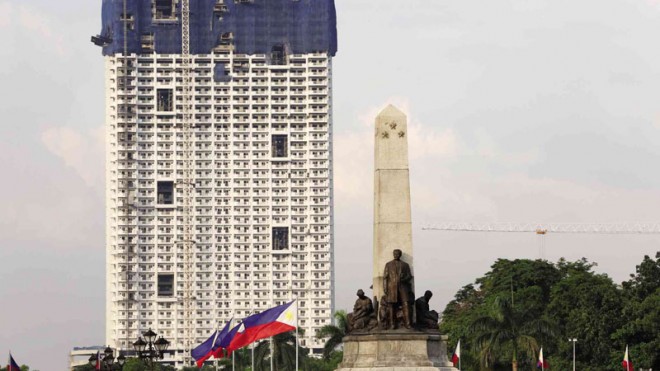Torre de Manila lawyer: Trick shots distorting truth
The lawyer for developer DM Consunji Inc. (DMCI), Victor Lazatin, dismissed the photos showing the Torre de Manila marring the vista of the monument as “trick shots” that distorted the truth.
The condominium was erected lawfully despite complaints that the building ruined the view of the Rizal Monument, the counsel of DMCI told the Supreme Court on Tuesday.
Lazatin also said that the condominium project had a social function as it provided affordable housing to the public, noting that at P70,000 per square meter, Torre de Manila was “cheap.”
At the oral arguments, the DMCI lawyer and Justice Francis Jardeleza, the assigned writer of the court’s opinion, debated on whether the Constitution’s provision on the conservation of the country’s historical and cultural heritage covered sight line, vista, visual corridor, dominance and settings applicable to monuments.
2 constitutional issues
The justice said that the case pertained to constitutional issues that have “far-reaching implications” and that DMCI had two things going against it: public right and injury in fact.
Jardeleza said the complaint of the Knights of Rizal pointed to an injury in fact since its members go to the monument twice a year and hold ceremonies there.
As for the public right, which the group claimed that DMCI violated, the justice said it would depend on the court’s interpretation of the applicability of three provisions in the Constitution pertaining to culture, particularly Article XIV, Section 15.
Conservation
The section states, “The State shall conserve, promote and popularize the nation’s historical and cultural heritage and resources, as well as artistic creations.”
When the Constitution was crafted in 1986 by the Constitutional Commission there were already definitions of the word “conservation,” which include vistas and settings of monuments, according to Jardeleza.
The justice cited international conventions in reply to Lazatin’s contention that the word “conserve” should not be interpreted technically.
Lazatin spoke before the justices to contest allegations that the Torre de Manila “photobombed” the Rizal Monument. He said photos on social media and newspapers showing the condominium looming over the monument were “trick shots that used photo lenses that distort the truth.”
He insisted that the lot where the condominium was built upon was not historical, having been the parking lot of the demolished Jai Alai building on Taft Avenue.
The high court issued a temporary restraining order (TRO) against the condominium project in June following a petition filed by the Knights of Rizal that the 49-story building ruined the view of the monument and thus disrespected national hero Jose Rizal, whose remains are entombed in the monument.
Damage to firm
Lazatin asked the Supreme Court to recall the TRO, saying DMCI had already suffered irreparable damage because the sale of units of the high-rise condominium was halted.
He added that construction workers were suffering from loss of income as they were temporarily deprived of their jobs.
The lawyer recalled a previous Supreme Court ruling that he said constituted the taking of a private property and therefore the owner should be compensated because it imposed limitations on private property to preserve the beauty of a public park.
Jardeleza said the court would decide the controversy “on the threshold” and “on purely legal issues,” adding that allegations of “photobombings” and undeserved criticism of DMCI were factual matters that the high tribunal, being not a trier of facts, cannot entertain.
Unesco convention
Jardeleza also referred to a 2003 Unesco convention on the protection of intangible cultural heritage, which the Philippines signed, and asked Lazatin whether it covered landscapes and settings of a monument.
Lazatin maintained that the protection afforded to the Rizal Monument only pertained to its physical integrity.
“The statue does not possess a super-constitutional power that acts as laser-sword that any building that exceeds the line of sight will be torn down,” he said.
Lazatin recalled that even the high court had planned to construct the Manila Hall of Justice near Torre de Manila.
Jardeleza pointed out that DMCI’s defense of its property rights clashed with “quintessential” values held by Filipinos, namely that property has a social function and that Rizal, being the national hero, and his final resting place, are held in reverence and awe.
Mere P655M profit
Lazatin claimed that Torre de Manila also served social functions as it would give affordable housing, with its cheap P70,000-per-square-meter cost. He said DMCI invested a total of P4.2 billion and expected a mere P655 million, or 17 percent, as profit.
“Nobody is saying that it is wrong with providing homes. The question is when your ability to make a profit collides with values [people hold about] culture. Why on earth of all places do you have to build where the Torre is?” Jardeleza replied.
The justice asked whether DMCI had a “land bank,” or other lots where they could have built Torre de Manila.
Lazatin advanced DMCI’s claim that it relied on the declaration of the National Historical Commission on the Philippines (NHCP) that the location of the high-rise was not a historical site.
However, Jardeleza said that since the lawyer “tabled” the issue, it would be the court that would interpret whether the NHCP followed its own guidelines in making the declaration.
‘Client took risk’
The last part of Jardeleza’s four-hour questioning pertained to whether DMCI conducted risk assessment and management in securing exemptions to a Manila zoning ordinance so that the company could construct the building and continue constructing despite mounting objections by cultural agencies and conservationists.
The zoning ordinance allows school and government buildings of only up to seven stories to rise in the area.
“Good faith cannot help your client because your client took a risk,” the justice said.
Acting Chief Justice Antonio Carpio adjourned the oral arguments at 6:30 p.m.
Lazatin will be questioned by other justices when the oral arguments resume on Aug. 11.















